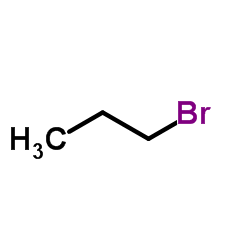1-Bromopropane

1-Bromopropane structure
|
Common Name | 1-Bromopropane | ||
|---|---|---|---|---|
| CAS Number | 106-94-5 | Molecular Weight | 122.992 | |
| Density | 1.3±0.1 g/cm3 | Boiling Point | 71.7±3.0 °C at 760 mmHg | |
| Molecular Formula | C3H7Br | Melting Point | -110 °C | |
| MSDS | Chinese USA | Flash Point | -4.5 ºC | |
| Symbol |



GHS02, GHS07, GHS08 |
Signal Word | Danger | |
|
Facile charge-displacement at silicon gives spaced-out reaction.
J. Am. Chem. Soc. 133(41) , 16560-5, (2011) Adsorbates on metals, but not previously on semiconductors, have been observed to display long-range repulsive interactions. On metals, due to efficient dissipation, the repulsions are weak, typically on the order of 5 meV at 10 Å. On the 7×7 reconstruction o... |
|
|
Apoptosis contributes to testicular toxicity induced by two isomers of bromopropanes.
Toxicol. Ind. Health 26(8) , 513-24, (2010) The aim of this study was to investigate the different testicular toxicity and the role of apoptosis in the possible mechanism induced by the two isomers of bromopropanes (BPs) in the same dosage. Following the 14-day treatment with a single dose of 1-BP and ... |
|
|
Neuro-reproductive toxicities of 1-bromopropane and 2-bromopropane.
Int. Arch. Occup. Environ. Health 78(2) , 79-96, (2005) 2-Bromopropane was used as an alternative to chlorofluorocarbons in a Korean electronics factory and caused reproductive and hematopoietic disorders in male and female workers. This causality was revealed by animal studies, and target cells were identified in... |
|
|
Exposure to 1-bromopropane induces microglial changes and oxidative stress in the rat cerebellum.
Toxicology 302(1) , 18-24, (2012) 1-Bromopropane (1-BP), an alternative to ozone-depleting solvents, is reported to exhibit neurotoxicity and reproductive toxicity in animals and humans. However, the underlying mechanism of the toxicity remains elusive. This study was designed to identify the... |
|
|
Monotonic Bayesian semiparametric benchmark dose analysis.
Risk Anal. 32(7) , 1207-18, (2012) Quantitative risk assessment proceeds by first estimating a dose-response model and then inverting this model to estimate the dose that corresponds to some prespecified level of response. The parametric form of the dose-response model often plays a large role... |
|
|
Effects of sub-acute and sub-chronic inhalation of 1-bromopropane on neurogenesis in adult rats.
Toxicology 304 , 76-82, (2013) 1-Bromopropane (1-BP) intoxication is associated with depression and cognitive and memory deficits. The present study tested the hypothesis that 1-BP suppresses neurogenesis in the dentate gyrus, which is involved in higher cerebral function, in adult rats.Fo... |
|
|
Occupational exposure to neurotoxic substances in Asian countries - challenges and approaches.
Neurotoxicology 33(4) , 853-61, (2012) The fact that a conference on neurotoxicity was held in China triggered the idea to provide an insight into occupational diseases, their development and the approaches to investigate them in Asian countries. A historical review, a meta-analysis, and studies o... |
|
|
In vitro human epidermal penetration of 1-bromopropane.
J. Toxicol. Environ. Health A 74(19) , 1249-60, (2011) 1-Bromopropane (1-BP; CAS number 106-94-5), also known as n-propyl bromide, is a halogenated short-chain alkane used as an organic solvent with numerous commercial and industrial applications, including garment dry cleaning and vapor degreasing of metals. The... |
|
|
1-Bromopropane up-regulates cyclooxygenase-2 expression via NF-κB and C/EBP activation in murine macrophages.
Food Chem. Toxicol. 50(5) , 1616-22, (2012) 1-Bromopropane (1-BP) has been used in industry as an alternative to ozone-depleting solvents. In the present study, we examined the effect of 1-BP on cyclooxygenase-2 (COX-2) gene expression and analyzed the molecular mechanism of its activity in murine RAW ... |
|
|
Multisite carcinogenicity and respiratory toxicity of inhaled 1-bromopropane in rats and mice.
Toxicol. Pathol. 39(6) , 938-48, (2011) Two-year 1-bromopropane (1-BP) inhalation studies were conducted because of the potential for widespread exposure, the lack of chronic toxicity and carcinogenicity data, and the known carcinogenicity of structurally related compounds. Male and female F344/N r... |